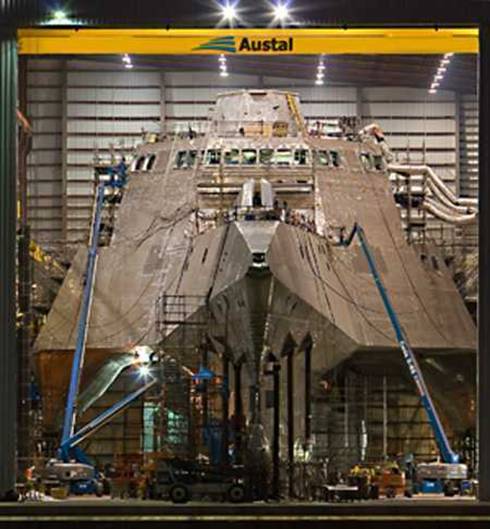Anyone Ever Seen One Of These Before?
Posted By thestatedtruth.com on September 23, 2009
The design for Independence (LCS 2) is based on a proven high-speed trimaran (Benchijigua Express) hull built by Austal (Henderson, Australia). The 127-meter surface combatant design calls for a crew of 40 sailors, while the trimaran hull should enable the ship to reach sustainable speeds of nearly 50Â knots (60Â mph; 90Â km/h) and range as far as 10,000Â nautical miles (20,000Â km).[citation needed]
With 11,000 cubic meters of payload volume the ship is designed with twice the objective payload and volume so that it can carry out one mission while a separate mission module is in reserve. The large flight deck, 1,030 m2 (11,100 sq ft), will support operation of two SH-60 helicopters, multiple UAVs, or one large CH-53 class helicopter (which is larger than a V-22 transport). The stable trimaran hull will allow flight operations up to sea state 5.[3]
Fixed core capabilities will be carried for self-defense and command and control. However unlike traditional fighting ships with fixed armament such as guns and missiles, innovative and tailored mission modules will be configured for one mission package at a time. Modules may consist of manned aircraft, unmanned vehicles, off-board sensors, or mission-manning detachments – all in an expandable open systems architecture.
The large interior volume and payload is greater than larger destroyers and is sufficient to serve as a high-speed transport and maneuver platform. The mission bay is 11,800Â square feet (1,100Â m2), and takes up most of the deck below the hangar and flight deck.[citation needed]
In addition to cargo or container-sized mission modules, the bay can carry four lanes of multiple Strykers, armored Humvees, and their associated troops. An elevator allows air transport of packages the size of a twenty-foot long shipping container that can be moved into the mission bay while at sea. A side access ramp allows for vehicle roll-on/roll-off loading to a dock and allows the ship to even transport the Expeditionary Fighting Vehicle.[4]
The habitability area is under the bridge with bunks for many personnel.
Independence also has an integrated LOS Mast, Sea Giraffe 3D Radar and SeaStar Safire FLIR. Side and forward surfaces are angled for reduced radar profile. In addition, H-60 series helicopters provide airlift, rescue, anti-submarine, radar picket and anti-ship capabilities with torpedoes and missiles.
The Raytheon Evolved SeaRAM missile defense system is installed on the hangar roof. The SeaRAM combines the sensors of the Phalanx 1B close-in weapon system with an 11-missile launcher for the Rolling Airframe Missile (RAM), creating an autonomous system.[5]
To reduce the risk of fire on the all aluminum ship, many parts are protected from fire, and smoking is not permitted on board.[6]
Northrop Grumman has demonstrated sensor fusion of on and off-board systems in the Integrated Combat Management System (ICMS) used on ‘Independence.[7]




Comments